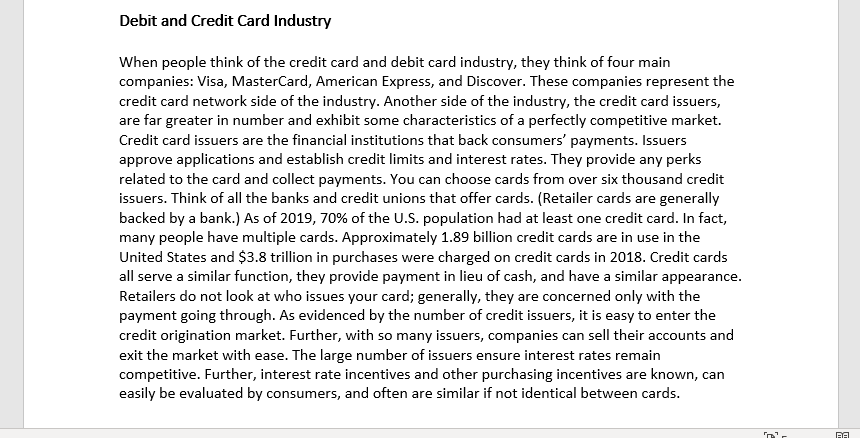Has the credit card industry become more or less competitive? Does it still fit the characteristics of perfect competition or is it moving away from being perfectly competitive? Does the fact that the credit card issuing industry meets some criteria of perfect competition benefit society? Why or Why not?
Has the credit card industry become more or less competitive? Does it still fit the characteristics of perfect competition or is it moving away from being perfectly competitive? Does the fact that the credit card issuing industry meets some criteria of perfect competition benefit society? Why or Why not?
Chapter1: Making Economics Decisions
Section: Chapter Questions
Problem 1QTC
Related questions
Question
Please answer both questions.
- Has the credit card industry become more or less competitive? Does it still fit the characteristics of perfect competition or is it moving away from being
perfectly competitive ? - Does the fact that the credit card issuing industry meets some criteria of perfect competition benefit society? Why or Why not?

Transcribed Image Text:Debit and Credit Card Industry
When people think of the credit card and debit card industry, they think of four main
companies: Visa, MasterCard, American Express, and Discover. These companies represent the
credit card network side of the industry. Another side of the industry, the credit card issuers,
are far greater in number and exhibit some characteristics of a perfectly competitive market.
Credit card issuers are the financial institutions that back consumers' payments. Issuers
approve applications and establish credit limits and interest rates. They provide any perks
related to the card and collect payments. You can choose cards from over six thousand credit
issuers. Think of all the banks and credit unions that offer cards. (Retailer cards are generally
backed by a bank.) As of 2019, 70% of the U.S. population had at least one credit card. In fact,
many people have multiple cards. Approximately 1.89 billion credit cards are in use in the
United States and $3.8 trillion in purchases were charged on credit cards in 2018. Credit cards
all serve a similar function, they provide payment in lieu of cash, and have a similar appearance.
Retailers do not look at who issues your card; generally, they are concerned only with the
payment going through. As evidenced by the number of credit issuers, it is easy to enter the
credit origination market. Further, with so many issuers, companies can sell their accounts and
exit the market with ease. The large number of issuers ensure interest rates remain
competitive. Further, interest rate incentives and other purchasing incentives are known, can
easily be evaluated by consumers, and often are similar if not identical between cards.
RA
Expert Solution
This question has been solved!
Explore an expertly crafted, step-by-step solution for a thorough understanding of key concepts.
This is a popular solution!
Trending now
This is a popular solution!
Step by step
Solved in 3 steps

Knowledge Booster
Learn more about
Need a deep-dive on the concept behind this application? Look no further. Learn more about this topic, economics and related others by exploring similar questions and additional content below.Recommended textbooks for you


Principles of Economics (12th Edition)
Economics
ISBN:
9780134078779
Author:
Karl E. Case, Ray C. Fair, Sharon E. Oster
Publisher:
PEARSON

Engineering Economy (17th Edition)
Economics
ISBN:
9780134870069
Author:
William G. Sullivan, Elin M. Wicks, C. Patrick Koelling
Publisher:
PEARSON


Principles of Economics (12th Edition)
Economics
ISBN:
9780134078779
Author:
Karl E. Case, Ray C. Fair, Sharon E. Oster
Publisher:
PEARSON

Engineering Economy (17th Edition)
Economics
ISBN:
9780134870069
Author:
William G. Sullivan, Elin M. Wicks, C. Patrick Koelling
Publisher:
PEARSON

Principles of Economics (MindTap Course List)
Economics
ISBN:
9781305585126
Author:
N. Gregory Mankiw
Publisher:
Cengage Learning

Managerial Economics: A Problem Solving Approach
Economics
ISBN:
9781337106665
Author:
Luke M. Froeb, Brian T. McCann, Michael R. Ward, Mike Shor
Publisher:
Cengage Learning

Managerial Economics & Business Strategy (Mcgraw-…
Economics
ISBN:
9781259290619
Author:
Michael Baye, Jeff Prince
Publisher:
McGraw-Hill Education